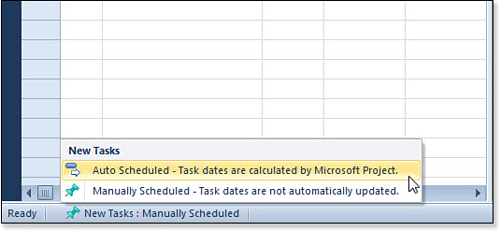The Task Mode in Microsoft Project 2010 is an
important new feature that, for the first time, enables project or
resource managers to employ the Project scheduling engine selectively.
Manually scheduled tasks will not move in response to changes in other
tasks. Auto-scheduled tasks employ the Project scheduling algorithms
experienced Project users are familiar with.
Setting the Task Mode
By default, the bottom-left corner of the project
window should display a control for a new task’s task mode. It should
say New Tasks: Manually Scheduled (see Figure 1).
This means that start dates, end dates, work, and so on all need to be
entered and maintained manually by the user. If this control is not
visible, right-click the status bar at the bottom of the screen. The
Customize Status Bar window should appear. Check the New Tasks control
to make it visible.

Selecting the New Tasks control opens the new task window (see Figure 2).
From here, you can select either Auto Scheduled or Manually Scheduled.
Remember, the choices on this control impact only new tasks.

You can change the task mode for existing tasks using one of two ways:
Right-click any column header and select
Insert Column. Select Task Mode. You can use the task mode column to
change a single or many tasks’ task mode.
Double-click
on the task row header. The Task Information window will appear. You
can set Schedule Mode to either Manually Scheduled or Auto Scheduled.
Understanding the Task Mode
The addition of manually scheduled Task Mode makes
it easier to record estimated task start and end dates, as well as
durations, because Project no longer automatically calculates them.
Experienced Project users will find this to be disconcerting at first.
The fundamental Project equation of Duration × Units = Work no longer
applies. Task dependencies are recorded but not honored.
The Manually Scheduled mode is intended for use
during project planning. Auto Scheduled mode is intended for use during
execution. In practical terms, users might find that they want a mix of
manually scheduled and auto-scheduled tasks at any one time.
For instance, when faced with a series of tasks that
must happen in sequence, managers will find auto scheduling very
useful. If Task A is not completed this week, Task B simply must be
rescheduled, and why bother doing it by hand if Project will do it for
you?
It is possible, however,
that within the same project, some tasks represent likely resource
usage. These are tasks (sometimes called Level of Effort or LOE
tasks) that represent time a resource will spend on the project,
without any pre-defined output. These kinds of task should probably
remain in manually scheduled mode throughout the project.